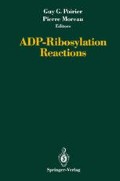Abstract
Most of the studies concerning the role of poly(ADP-ribosyl)ation in cellular physiology relied on NAD analogs, e.g. benzamide and derivatives, as competitive PARP* inhibitors. Since such drugs have side-effects on other cellular functions we decided to overexpress selectively the PARP DNA-binding domain as a dominant-negative mutant of for inhibiting this enzyme activity in a highly specific manner (Küpper et al., 1990). Here we review the construction of eucaryotic expression plasmids carrying the PARP full-length open reading frame and a truncated cDNA coding for the DNA-binding domain, respectively. Transfection of these constructs into eucarytic cell lines and monitoring PARP activity in transfected cells clearly showed enhanced enzyme activity in the case of overexpression of the full-length open reading frame. By contrast, transfection of plasmids coding for the DNA-binding domain resulted in a drastic inhibition of poly(ADP-ribosyl)ation, as predicted (Küpper et al., 1990).
Article FootNote
The abbreviations used are: FITC, fluorescein isothiocyanate; HEF, human embryonic fibroblasts; MNNG, N-methyl-N’-nitro-N-nitrosoguanidine; PARP, poly(ADP-ribose) polymerase; PBS, phosphate-buffered saline; PCR, polymerase chain reaction; SV40, Simian virus 40; TCA, trichloro acetic acid; TRITC, tetramethylrhodamine isothiocyanate.
Access this chapter
Tax calculation will be finalised at checkout
Purchases are for personal use only
Preview
Unable to display preview. Download preview PDF.
References
Cherney, B. W.; McBride, O. W.; Chen, D.; Alkhatib, H.; Bhatia, K.; Hensley, P.; Smulson, M. E. cDNA sequence, protein stucture, and chromosomal location of the human gene for poly(ADP-ribose) polymerase. Proc. Natl. Acad. Sci. USA 84: 8370–8374; 1987
Chomczynski, P.; Sacchi, N. Single step method of RNA isolation by acid guanidinium thiocyanate-phenol-chloroform extraction. Anal. Biochem. 162: 156–159; 1986
Dunning, A. M.; Talmud, P.; Humphries, S. E. Errors in the polymerase chain reaction. Nucleic Acids Res. 16: 10393; 1988
Gradwohl, G.; Ménissier de Murcia, J.; Molinete, M.; Simonin, F.; Koken, M.; Hoeijmakers, J. H. J.; de Murcia, G. The second zinc-finger domain of poly(ADP-ribose) polymerase determines specificity for single-stranded breaks in DNA. Proc. Natl. Acad. Sci. USA 87: 2990–2994; 1990
Grube, K.; Küpper, J. H.; Bürkle, A. Direct stimulation of poly(ADP-ribose) polymerase in permeabilized cells by double-stranded DNA oligomers. Anal. Biochem. 193: 236–239; 1991
Harbarth, P.; Vosberg, H.-P. Enzymatic amplification of myosin heavy-chain mRNA sequences in vitro. DNA 7: 297–306; 1988
Ikai, K.; Ueda, K.; Hayaishi, O. Immunohistochemical demonstration of poly(adenosine diphosphate-ribose) in nuclei of various rat tissues. J. Histochem. Cytochem. 28: 670–676; 1980
Kameshita, I.; Matsuda, Z.; Taniguchi, T.; Shizuta, Y. Poly(ADP-ribose) synthetase. Separation and identification of three proteolytic fragments as the substrate-binding domain, the DNA-binding domain, and the automodification domain. J. Biol. Chem. 259: 4770–4776; 1984
Kawamitsu, H.; Hoshino, H.; Okada, H.; Miwa, M.; Momoi, H.; Sugimura, T. Monoclonal antibodies to poly(adenosine diphosphate ribose) recognize different structures. Biochemistry 23: 3771–3777; 1984
Küpper, J. H.; de Murcia, G.; Bürkle, A. Inhibition of poly(ADPribosyl)ation by overexpressing the poly(ADP-ribose) polymerase DNA-binding domain in mammalian cells. J. Biol. Chem. 265: 18721–18724; 1990
Kurosaki, T.; Ushiro, H.; Mitsuuchi, Y.; Suzuki, S.; Matsuda, M.; Matsuda, Y.; Katununva, N.; Kangawa, N.; Matsuo, H.; Hirose, T.; Inayama, S.; Shizuta, Y. Primary structure of human poly(ADP-ribose) synthetase as deduced from cDNA sequence. J. Biol. Chem. 262: 15990–15997; 1987
Maniatis, T.; Fritsch, E. F.; Sambrook, J. Molecular cloning. A laboratory manual. Cold Spring Harbor Laboratory; 1982
Saiki, R. K.; Gelfand, D. H.; Stoffel, S.; Scharf, S. J.; Higuchi, R.; Horn, G. T.; Mullis, K. B.; Erlich, H. A. Primer-directed enzymatic amplification of DNA with a thermostable DNA polymerase. Science 239: 487–491; 1988
Scovassi, A. I.; Stefanini, M.; Bertazzoni, U. Catalytic activities of human poly(ADP-ribose) polymerase from normal and mutagenized cells detected after sodium dodecyl sulfate-polyacrylamide gel electrophoresis. J. Biol. Chem. 259: 10973–10977; 1984
Uchida, K.; Morita, T.; Sato, T.; Ogura, T.; Yamashita, R.; Noguchi, S.; Suzuki, H.; Nyunoya, H.; Miwa, M.; Sugimura, T. Nucleotide sequence of a full-length cDNA for human fibroblast poly(ADP-ribose) polymerase. Biochem. Biophys. Res. Commun. 148: 617–622; 1987
Editor information
Editors and Affiliations
Rights and permissions
Copyright information
© 1992 Springer Science+Business Media New York
About this paper
Cite this paper
Küpper, JH., Bürkle, A. (1992). Expression of the DNA-Binding Domain of Human Poly(ADP-Ribose) Polymerase as a Trans-Dominant Inhibitor of Poly(ADP-Ribosyl)ation in Transfected Eucaryotic Cell Lines. In: Poirier, G.G., Moreau, P. (eds) ADP-Ribosylation Reactions. Springer, New York, NY. https://doi.org/10.1007/978-1-4419-8718-1_5
Download citation
DOI: https://doi.org/10.1007/978-1-4419-8718-1_5
Publisher Name: Springer, New York, NY
Print ISBN: 978-1-4612-6456-9
Online ISBN: 978-1-4419-8718-1
eBook Packages: Springer Book Archive

